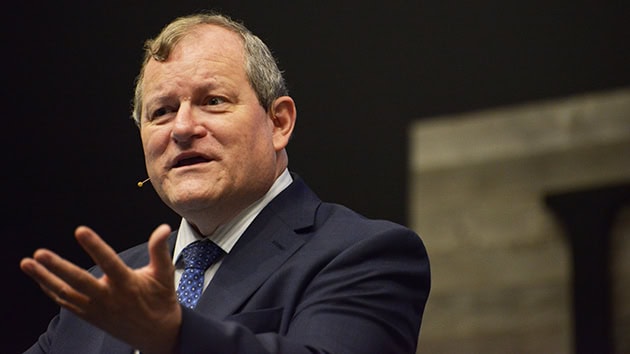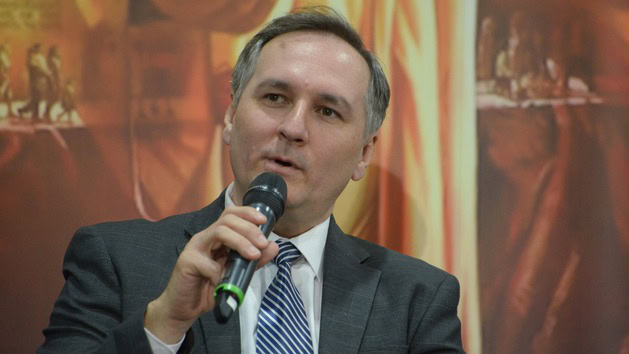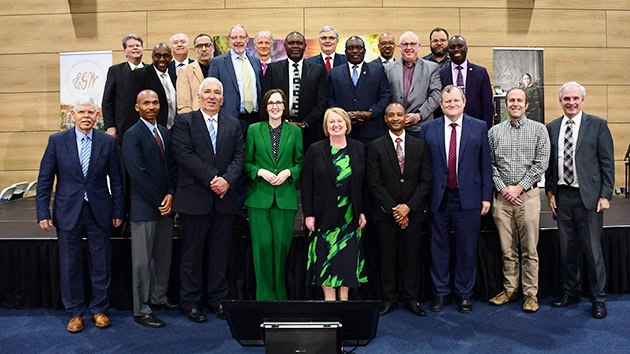Still a Prophetic Voice in Europe?

Artist’s rendering of Ellen G. White. [Photos: James Botha, David Neal, and Vanesa Pizzuto]
May 6, 2024 | David Neal and Vanesa Pizzuto, tedNEWS
The Ellen G. White Symposium, “Understanding Ellen G. White and Her Prophetic Gift Today,” took place on the campus of Newbold College of Higher Education in Bracknell, England, April 19-21.
It was intentionally planned to coincide with the 50th anniversary of the first European Ellen G. White Research Center. “This center is very special because it was the first outside North America, which became the template for the other 19 research centers that we now have around the globe,” Audrey Andersson, a general vice president of the General Conference and chair of the Ellen G. White Estate, explained.

Merlin D. Burt appealed to his listeners about the love of God as Ellen White understood it. “Know it, believe it, experience it.” [Photos: James Botha, David Neal, and Vanesa Pizzuto]
The symposium, sponsored by the Trans-European Division (TED), attracted a diverse audience of between 800 and 1,000 participants, including pastors, administrators, teachers, and members from across the TED territory. The youngest of these included a group of Scottish Mission Pathfinders from Glasgow attending as a partial requirement of their “God’s Messenger” honor.
How Not to Read Ellen White Today
Dealing with one of the specific challenges to understanding Ellen White today, Jan Barna, principal lecturer in systematic and biblical theology and head of research at Newbold, clarified that because Ellen White wrote from a different culture, time, language, and worldview than our current experience, there is a need for “interpretation” of what is written, so that we do not misunderstand the intent of what the author is wanting to share.
While “the historical and cultural gap is between roughly 100 to 170 years,” Barna explained, “given how humanity has changed over just the last 50 years of my lifetime, there is a big gap. And this is just on the level of the historical-cultural horizon.” His plea is that we “proceed carefully” as we try to interpret what Ellen White has to share.

Jan Barna’s concern is that to gain an intelligent understanding of what Ellen White has to share, interpretation is required. [Photos: James Botha, David Neal, and Vanesa Pizzuto]
His appeal: “Expect to hear the prophetic voice from the author and her text, and do so on the terms of Ellen White herself and not the terms of the reader.”
A Female, Embodied Prophet
Kevin Burton, the director of the Center for Adventist Research at Andrews University in Berrien Springs, Michigan, presented a session entitled “Ellen G. White: Literary Source and Gender.” In what proved to be one of the most thought-provoking presentations of the symposium, Burton explored Ellen White’s role as a female prophet and how gender biases have influenced the perspectives of both critics and apologists regarding her work.
Burton remarked, “A common thread among members of both camps is their perception of Ellen White’s female body as problematic.” He went on to discuss how apologists often misinterpreted her frailty as evidence of her prophetic abilities, while critics tended to attribute her visions to various diseases, such as hysteria and histrionic personality disorder (HPD), using unreliable retrospective diagnoses.
“Every aspect of Ellen White’s life, including her visions, was mediated by her female body,” Burton said, prompting the audience to consider what it would entail to approach her work with honor and respect for her female body.

Audrey Andersson (front row center), chair of the Ellen G. White Estate Board, flanked by guest presenters and leaders from across the Trans-European Division. [Photos: James Botha, David Neal, and Vanesa Pizzuto]
Pointing to the lack of historical evidence to support this theory, Burton reflected, “It is ludicrous to think that she was God’s last choice and to connect this with her gender and femininity is lamentable.… If anything, I’d be more inclined to think God chose her precisely because she was a woman … to make a point about the equality between the sexes for us today.”
One Challenge Easy to Solve
When asked about the challenges of interpreting Ellen White’s writings, Andersson responded, “One challenge is that people simply don’t read Ellen White.” She proposed an experiment: “Take something simple like [the book] Steps to Christ and read a portion every day.… It will draw you closer to the Bible.”
Mendez further emphasized that reading White’s works reveals a clearer picture of God’s love. “The Conflict of the Ages series3 begins and ends with the phrase ‘God is love.’ This encapsulates the overarching message of her writings.”
Shaped the Past, Guides Us in Our Present, Inspires Our Future
Reflecting on the symposium, TED president Daniel Duda said, “We are thankful for how God used Ellen White to bless the Advent movement. At this symposium, we have been blessed to explore the enduring legacy of Ellen White, her profound impact on spirituality, education, and health. She has not only shaped the past of our church but continues to guide us in our present and inspire our future. If there is no forward movement in our lives, then something is seriously wrong. If there is no advancement in our lives, we are not led by the Spirit. Because where there is God’s Spirit, there is freedom to move forward; people are free to learn and to unlearn. We become the agents of hope, which is what our European society needs nowadays.”
The original version of this story was posted by tedNEWS.
______________________________________
1. Ellen G. White interview with C. C. Crisler, July 21, 1914, Ellen G. White Estate.
2. See, for example, Letter 37, December 22, 1890, Ellen White to Mary Foss (Letters and Manuscripts, Vol. 6 [1889–1890]).
3. The Conflict of the Ages series of books by Ellen White includes Patriarchs and Prophets, Prophets and Kings, The Desire of Ages, The Acts of the Apostles, and The Great Controversy.
Read more at: https://adventistreview.org/news/still-a-prophetic-voice-in-europe/